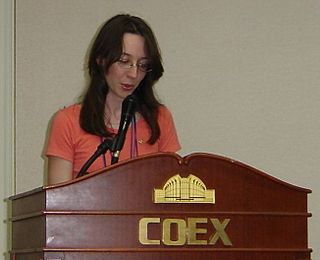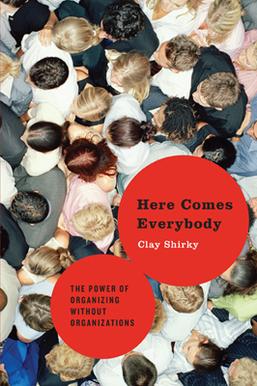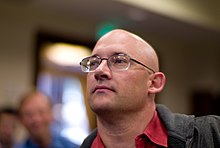
A wiki is an online hypertext publication collaboratively edited and managed by its own audience, using a web browser. A typical wiki contains multiple pages for the subjects or scope of the project, and could be either open to the public or limited to use within an organization for maintaining its internal knowledge base.
Social software, also known as social apps or social platform includes communications and interactive tools that are often based on the Internet. Communication tools typically handle capturing, storing and presenting communication, usually written but increasingly including audio and video as well. Interactive tools handle mediated interactions between a pair or group of users. They focus on establishing and maintaining a connection among users, facilitating the mechanics of conversation and talk. Social software generally refers to software that makes collaborative behaviour, the organisation and moulding of communities, self-expression, social interaction and feedback possible for individuals. Another element of the existing definition of social software is that it allows for the structured mediation of opinion between people, in a centralized or self-regulating manner. The most improved area for social software is that Web 2.0 applications can all promote co-operation between people and the creation of online communities more than ever before. The opportunities offered by social software are instant connections and opportunities to learn.An additional defining feature of social software is that apart from interaction and collaboration, it aggregates the collective behaviour of its users, allowing not only crowds to learn from an individual but individuals to learn from the crowds as well. Hence, the interactions enabled by social software can be one-on-one, one-to-many, or many-to-many.
In politics, emergent democracy represents the rise of political structures and behaviors without central planning and by the action of many individual participants, especially when mediated by the Internet. It has been likened to the democratic system of ancient Greece in the sense that people could publicly participate as much or as little as they please, although a form of representation exists which is based on personal trust networks instead of party affiliations. More recently, American writer and researcher Clay Shirky has referred to this as "the power of organizing without organizations."
Open-source journalism, a close cousin to citizen journalism or participatory journalism, is a term coined in the title of a 1999 article by Andrew Leonard of Salon.com. Although the term was not actually used in the body text of Leonard's article, the headline encapsulated a collaboration between users of the internet technology blog Slashdot and a writer for Jane's Intelligence Review. The writer, Johan J. Ingles-le Nobel, had solicited feedback on a story about cyberterrorism from Slashdot readers, and then re-wrote his story based on that feedback and compensated the Slashdot writers whose information and words he used.

Citizen journalism, also known as collaborative media, participatory journalism, democratic journalism, guerrilla journalism or street journalism, is based upon public citizens "playing an active role in the process of collecting, reporting, analyzing, and disseminating news and information." Similarly, Courtney C. Radsch defines citizen journalism "as an alternative and activist form of news gathering and reporting that functions outside mainstream media institutions, often as a response to shortcomings in the professional journalistic field, that uses similar journalistic practices but is driven by different objectives and ideals and relies on alternative sources of legitimacy than traditional or mainstream journalism". Jay Rosen offers a simpler definition: "When the people formerly known as the audience employ the press tools they have in their possession to inform one another." The underlying principle of citizen journalism is that ordinary people, not professional journalists, can be the main creators and distributors of news. Citizen journalism should not be confused with community journalism or civic journalism, both of which are practiced by professional journalists; collaborative journalism, which is the practice of professional and non-professional journalists working together; and social journalism, which denotes a digital publication with a hybrid of professional and non-professional journalism.

A collaboration tool helps people to collaborate. The purpose of a collaboration tool is to support a group of two or more individuals to accomplish a common goal or objective. Collaboration tools can be either of a non-technological nature such as paper, flipcharts, post-it notes or whiteboards. They can also include software tools and applications such as collaborative software.

Flickr is an American image hosting and video hosting service, as well as an online community, founded in Canada and headquartered in the United States. It was created by Ludicorp in 2004 and was a popular way for amateur and professional photographers to host high-resolution photos. It has changed ownership several times and has been owned by SmugMug since April 20, 2018.

In statistics and business, a long tail of some distributions of numbers is the portion of the distribution having many occurrences far from the "head" or central part of the distribution. The distribution could involve popularities, random numbers of occurrences of events with various probabilities, etc. The term is often used loosely, with no definition or an arbitrary definition, but precise definitions are possible.

Web 2.0 refers to websites that emphasize user-generated content, ease of use, participatory culture and interoperability for end users.

Clay Shirky is an American writer, consultant and teacher on the social and economic effects of Internet technologies and journalism.

Citizen media is content produced by private citizens who are not professional journalists. Citizen journalism, participatory media and democratic media are related principles.

User-generated content (UGC), alternatively known as user-created content (UCC), is any form of content, such as images, videos, text, testimonials, and audio, that has been posted by users on online platforms such as social media, discussion forums and wikis. It is a product consumers create to disseminate information about online products or the firms that market them.

Wikinomics: How Mass Collaboration Changes Everything is a book by Don Tapscott and Anthony D. Williams, first published in December 2006. It explores how some companies in the early 21st century have used mass collaboration and open-source technology, such as wikis, to be successful.
Participatory culture, an opposing concept to consumer culture, is a culture in which private individuals do not act as consumers only, but also as contributors or producers (prosumers). The term is most often applied to the production or creation of some type of published media.

A civil society campaign is one that is intended to mobilize public support and use democratic tools such as lobbying in order to instigate social change. Civil society campaigns can seek local, national or international objectives. They can be run by dedicated single-issue groups such as Baby Milk Action, or by professional non-governmental organisations (NGOs), such as the World Development Movement, who may have several campaigns running at any one time. Larger coalition campaigns such as 2005's Make Poverty History may involve a combination of NGOs.
Collaborative mapping, also known as citizen mapping, is the aggregation of Web mapping and user-generated content, from a group of individuals or entities, and can take several distinct forms. With the growth of technology for storing and sharing maps, collaborative maps have become competitors to commercial services, in the case of OpenStreetMap, or components of them, as in Google Map Maker Waze and Yandex Map Editor.

Here Comes Everybody: The Power of Organizing Without Organizations is a book by Clay Shirky published by Penguin Press in 2008 on the effect of the Internet on modern group dynamics and organization. The author considers examples such as Wikipedia, MySpace, and other social media in his analysis. According to Shirky, the book is about "what happens when people are given the tools to do things together, without needing traditional organizational structures". The title of the work alludes to HCE, a recurring and central figure in James Joyce's Finnegans Wake and considers the impacts of self-organizing movements on culture, politics, and business.

In Internet culture, the 1% rule is a general rule of thumb pertaining to participation in an internet community, stating that only 1% of the users of a website actively create new content, while the other 99% of the participants only lurk. Variants include the 1–9–90 rule, which states that in a collaborative website such as a wiki, 90% of the participants of a community only consume content, 9% of the participants change or update content, and 1% of the participants add content.

Cognitive Surplus: How Technology Makes Consumers into Collaborators is a 2010 non-fiction book by Clay Shirky, originally published in with the subtitle "Creativity and Generosity in a Connected Age". The book is an indirect sequel to Shirky's Here Comes Everybody, which covered the impact of social media. Cognitive Surplus focuses on describing the free time that individuals have to engage with collaborative activities within new media. Shirky's text searches to prove that global transformation can come from individuals committing their time to active engagement with technology. Overall response has been mixed with some critics praising Shirky's insights but also decrying some of the shortcomings of his theory.

Produsage is a portmanteau of the words production and usage, coined by Australian media scholar Axel Bruns and popularized in his book Blogs, Wikipedia, Second Life and Beyond: From Production to Produsage. Produsage is the type of user-led content creation that takes place in a variety of online environments, open source software, and the blogosphere. The concept blurs the boundaries between passive consumption and active production. The distinction between producers and consumers or users of content has faded, as users play the role of producers whether they are aware of this role or not. The hybrid term produser refers to an individual who is engaged in the activity of produsage. This concept is similar and related to commons-based peer production, a term coined by Yochai Benkler.



















